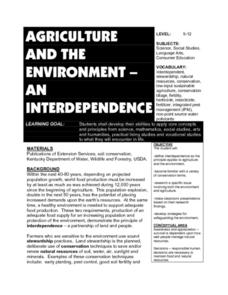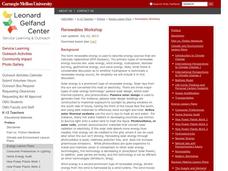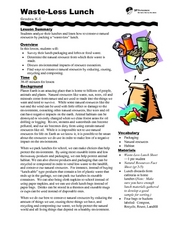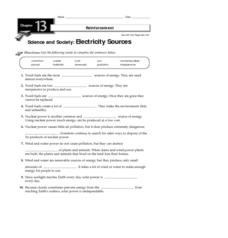Virginia Department of Education
The Germ Theory and Koch’s Postulates
Explore the history of cholera and its effect on society with your biology class. Young biologists will then proceed to grow their own germs, prepared from live cultures, and follow the steps of the scientific method to generate data....
Curated OER
Fourth Grade Science
In this science worksheet, 4th graders answer multiple choice questions about coastlines, electric cars, the food chain, and more. Students complete 25 questions.
Curated OER
Agriculture and the Environment
Students investigate the interdependence of agriculture and the environment. They research areas of interdependence and provide examples of situations where farmers are practicing conservation in the local area. Their findings are...
Carnegie Mellon University
Renewables Workshop
Youngsters examine resource maps to find out which states are using solar and wind power and discuss as a class various other renewable energy sources. They use a provided data table to record pros and cons to each technology, build and...
Curated OER
Don't Let the Earth Down
Writing a persuasive argument starts with a clear thesis. Using this resource, your class will write a persuasive paper on a conservation issue. They will then transform their argument into a 30-second public service announcement. If...
Curated OER
Don't Let the Earth Down
Although recycling is definitely beneficial, reducing our waste and conserving our natural resources should really be the focus of environmentalists. Encourage the future generation to create a public service announcement about a...
Forest Foundation
Fire - How Does it Relate to You?
Forest fires can be a necessary step in keeping a forest healthy, but what happens when they get out of control? Learners investigate the causes and effects of forest fires in two specific areas, culminating in a report about the ways...
Curated OER
Arkansas and NAFTA
Build literacy through social studies and reading strategies. This instructional activity focuses on using pre-reading, vocabulary building, and comprehension questions to boost literacy while educating learners on international trade,...
Curated OER
Earth: Our Big Blue Marble
Students investigate Earth and its resources. In this Earth, space, and nature lesson plan, students collaborate to design presentations on the Earth, its cycles, and how humans have impacted the planet. Images, diagrams, and background...
SF Environment
Waste-Less Lunch
Is it possible to have a waste-less lunch? Can your class become leaders in conservation? Discuss the importance of reducing waste during lunch time with a fun lesson that can be extended to everyday practices. First the class examines...
Bethel School District
Observations and Inference
What's the difference between qualitative and quantitative observations? Learners make observations, inferences, and predictions about their environment with a set of questions and activities that are applicable to either language...
Curated OER
Using Maps To Make Public Health Decisions Case Study: Wildfires in Mexico 2000
High schoolers study environmental health. Using actual NOAA satellite imagery, students investigate the basic concepts of mapping. They explore the relationship between monitoring satellite images and public health decision making.
Curated OER
Suspended Particulates lab
Students observe differences between suspended particulates and a solution, and classify common atmospheric gases and particulates. They explain what they think the word suspended means. Students observe the differences between what...
Curated OER
Chemical Reactions and Burning Fossil Fuels
In this chemistry learning exercise, students select answers to 24 multiple choice questions using the drop down box. They identify the different atoms involved in the chemical reaction.
Curated OER
Acid Rain
Young scholars investigate the effects of acid rain. The lesson contains a lab background for the teacher to use before the implementation of the lesson. They conduct an experiment to collect data and then report the results of the...
Curated OER
The Urban Heat Island Effect - Lesson 2 (Grades 8-9)
Students use the scientific process to show that when various surfaces are exposed to similar environmental conditions, surface temperatures may vary. They examine the "urban heat island" phenomenon and analyze why it increases energy...
Curated OER
Weather & Climate; Knowledge Quiz
In this weather and climate quiz worksheet, students complete a set of 10 multiple choice questions covering a variety of concepts related to climate and weather.
Curated OER
Electricity Sources
In this electricity learning exercise, students review the different types of energy sources including fossil fuels, solar, wind, and nuclear energy. This learning exercise has 10 fill in the blank questions.
Curated OER
Clean Coal Technology
For this clean coal worksheet, students click on the links to learn more about clean coal technology and answer short answer questions about it. Students complete 12 questions total.
Curated OER
Create a Commercial
Learners apply their knowledge of the persuasive appeals by creating a commercial which uses one or more of the three appeals (logos, pathos, and ethos) in order to persuade. They also differentiate among the three appeals as used in...
Curated OER
Help! Someone Has Destroyed My Home!
Fifth graders use a mystery bag to discover ways in which humans endanger the life of animals by changing their habitat. In this animal habitat lesson, 5th graders work with a partner to design a solution to the problem of habitat...
Curated OER
Green Building and Development
In this environment worksheet, students find the solutions to building an environmentally friendly home and they examine the long-terms costs associated with ownership.
Curated OER
Ralph Nader
In this online interactive Ralph Nader worksheet, students respond to 15 fill in the blank and multiple choice questions regarding the information included in the provided paragraphs.
Curated OER
Building A Topographic Model
Students visualize, in three dimensions, features represented by contour lines on a topographic map. They see that the different elevations shown on a two dimensional topographic map can be used to build a 3-D model.

























